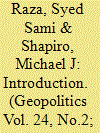| Srl | Item |
| 1 |
ID:
164731


|
|
|
|
|
| Summary/Abstract |
This research focuses on the relationship between the tribe and the state in Pakistan’s Western borderlands and how this relationship has been continuously affected by the security needs of the state. I argue that there is a dialectical relationship between the tribe and the state. Both of them represent an authority structure, institutions, leadership and rules and procedures to govern populations. While the logic of the state and the modern notions of national sovereignty and territorial control would require assimilation of the tribe into the larger national community, the tribe and its chieftain would strive to maintain their autonomy, traditions and time-tested political arrangements that have served their purpose. The ethos and structural needs of the two to survive and develop – for the state to expand and the tribe to resist and maintain its relative autonomy – clash.
|
|
|
|
|
|
|
|
|
|
|
|
|
|
|
|
| 2 |
ID:
164730


|
|
|
|
|
| Summary/Abstract |
This special issue focuses on the Pakistan-Afghanistan borderland. It collects a set of articles that return in different ways to the common theme of “politics on border.” It makes a series of interdisciplinary forays to make the Pakistan-Afghanistan border politically more legible. The borderland is presented from multiple methodological approaches and critical perspectives. It focuses on certain hitherto untouched or least debated dimensions of this border, for instance the status of women in the border-culture, the concept of alienage in the making of border, extensions and manifestations of the border, and political aesthetics of the border.
|
|
|
|
|
|
|
|
|
|
|
|
|
|
|
|
| 3 |
ID:
164736


|
|
|
|
|
| Summary/Abstract |
This paper explores the cultural status of tribal women living in the Pakistan–Afghanistan borderland. Pakhtun tribes, a patriarchal and paternalistic society, practising tribal customs (Riwaj/Dastoor), inhabit this borderland. Owing to these tribal customs, the tribal Pakhtun society treats women much like property of their men. This essay focuses on how a tribal woman is socially discriminated by denying her certain fundamental rights. I discuss six tribal customs, by giving examples based on my field work, through which tribal women are treated as personal property by her male kin—father, brother, uncle or husband. These customs include shamilaat (denial of the right to inheritance in shared family’s and tribe’s property), miratah (declaring a woman as issueless in the absence of a male kin and thereby denying her property), rasnama/valver/khawara (bride-money), ghairat/nang (honour and pride), badala/swara (barter, as in getting father or brother a bride or as in exchange for settlement of dispute) and ghag (pronouncing the desire to marry a specific woman or in some cases to spite a family).
|
|
|
|
|
|
|
|
|
|
|
|
|
|
|
|